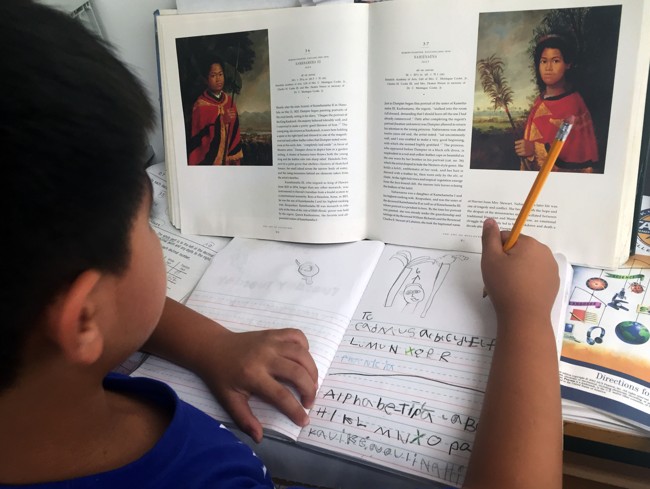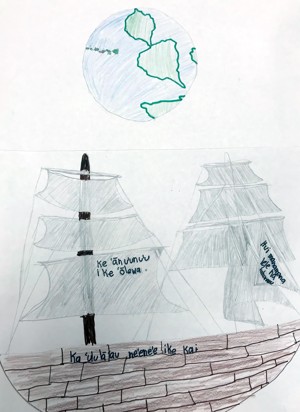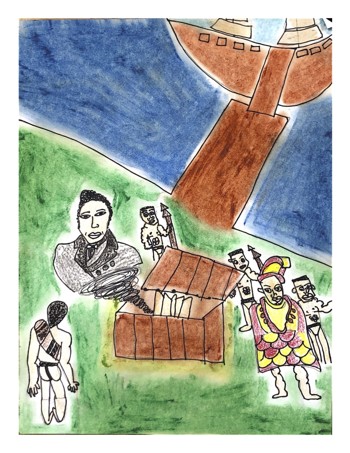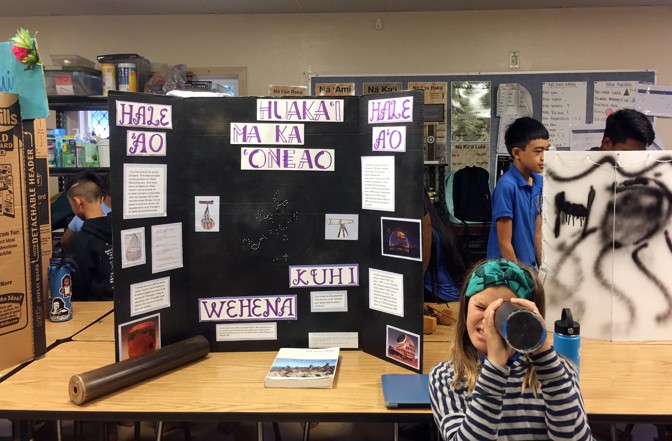
How to Save a Dying Language
by Alia Wong- Link Copied
Editor's Note: In the next five years, most of America’s most experienced teachers will retire. The Baby Boomers are leaving behind a nation of more novice educators. In 1988, a teacher most commonly had 15 years of experience. Less than three decades later, that number had fallen to just three years leading a classroom. The Atlantic’s “On Teaching” project is crisscrossing the country to talk to veteran educators. This story is the ninth in our series.
The orphan was surveying the sea from atop a lava-rock shrine when he saw them—omens that looked just as his uncle, a kahuna, had foretold. There was a flock of airborne stingrays amid a series of towers, all hovering over a forest floating above the surface.
The orphan sounded the alarm as soon as the apparition materialized, just as the kahuna had instructed. But then the boy’s curiosity got the best of him. He ran down to the shore and immediately began swimming. And as he swam he realized: It wasn’t divine intervention—at least, not directly. Rather, what he saw as an omen was a massive, man-made object. And inside that object were actual men, who saw the boy in the water and called to him, inviting him aboard.
The boy found himself among American sailors on a commercial seafaring expedition, one that eventually took him thousands of miles away, to Connecticut. That’s where the boy stayed until he died from typhus a decade later, in 1818, just as he was preparing to finally return to his island home.
Kaipo‘i Kelling, a longtime educator who teaches fifth and sixth graders at one of Hawaii’s several dozen Hawaiian-language immersion schools, told me this mo‘olelo—“story,” “legend,” “history”—because he wanted to make a point. Hawaii is still witnessing the ripple effects of this fateful moment two centuries ago. The merchant seamen from the United States whom the boy encountered, coupled with the wave of American missionaries who followed that ship, fundamentally altered the Hawaiian way of life, nearly destroying the Hawaiian language along the way. In fact, it’s a miracle the language survived at all after what happened in Honolulu in 1893.
In January of that year, a group of businessmen backed by the American ambassador overthrew Hawaii’s monarchy, laying the groundwork for annexation to the United States. The territorial government established English as the only official language. From then on, people caught speaking Hawaiian faced severe social ostracism.
The English-only law had an immediate chilling effect that prevented subsequent generations of Native Hawaiians from learning their linguistic ancestry. Preannexation, Native Hawaiians were some of the world’s most gifted communicators, with centuries of history and culture bound to an oral tradition. The arrival of missionaries had by the mid-1800s brought the printed word, and led to the creation of a slew of Hawaiian-language newspapers—or nūpepa. According to a write-up by Kamehameha Schools, by 1834, more than nine in 10 Hawaiians were literate, up from close to zero percent just a dozen years prior.
Read: De-stigmatizing Hawaii’s creole language
But as literacy rose, other aspects of Hawaiian culture receded—including the kapu system of governance, which enforced strict social rules; the low-fat, nutrient-rich diet; the kapa-bark clothing; and the hula as a sacred form of cultural and spiritual expression. This was not the first time Hawaiians had experienced loss at this scale. A century before the overthrow, British explorers brought diseases that decimated the Native Hawaiian population. By the time Hawaii became a state, in 1959, the Hawaiian language had lost a critical mass of native speakers. According to one study, fewer than 30 students were studying Hawaiian at the University of Hawai‘i’s flagship campus during the school year that began in 1960. Other indigenous languages were undergoing their own protracted deaths—roughly 230 of them went extinct at some point between 1950 and 2010. In the ’60s, estimates suggest that fewer than 2,000 people could speak Hawaiian fluently, and just a few dozen of them were children.
But then something remarkable happened. An unlikely Hawaiian renaissance blossomed in the ’60s and into the ’70s, initially driven by artists who sought to reclaim traditional music and dance. Ironically, the rise of Hawaii’s tourism industry, spurred by advances in aviation, helped support this renaissance, because visitors wanted to experience Hawaiian culture. Tiki bars and commercialized luaus were a poor substitute for what was lost in the overthrow, but the appropriation of Hawaiianness allowed the authentic aspects of Hawaiian life to creep back in. Then, in 1978, the state of Hawaii held a constitutional convention, prompted in part by questions about land rights and a return of Native Hawaiian sovereignty. Among other measures aimed at improving natives’ well-being, the convention made Hawaiian an official language for the first time since the kingdom had fallen.

This move enabled the beginnings of the modern-day Hawaiian-immersion movement—the one Kelling, the educator, is now striving to advance. Activists “knew that raising children in an environment where Hawaiian was the ordinary language of interaction was central to the survival of the language,” reads a historical overview of ‘Aha Pūnana Leo, a leading Hawaiian-immersion organization that founded its first early-education program on Kaua‘i in the mid-’80s. Later, Pūnana Leo launched a preschool out of downtown Honolulu’s historic schoolhouse and church—whose surrounding graveyard memorializes missionaries and plantation tycoons, and where Kelling began his teaching career in the early ’90s. Today, Pūnana Leo—whose name translates into “nest of voices”—comprises 12 programs across the state.
Once the Pūnana Leo movement took off, a network of activists set its sights on rescinding the Hawaiian-language prohibition in public schools, which remained codified in the constitution (even if it wasn’t enforced in practice). “The most significant language initiative has been the development of Hawaiian immersion preschool and K-12 education,” two UH scholars wrote in a 1997 analysis, because “this is potentially a way of reversing the decline of fluent young speakers.” Today, roughly two dozen of Hawaii’s public schools teach exclusively in Hawaiian, about a third of them charters.
The number of Hawaiian speakers in the state is now 18,000, roughly half of them fluent.
“So what’s the forest?” Kelling asked me, returning to the mo‘olelo about the orphan. We were leaning on a table in his classroom at Ke Kula ‘o Samuel M. Kamakau, a Hawaiian-immersion charter school on O‘ahu whose campus is tucked amid wetlands and ancient fishponds in a region separated from Honolulu by a prehistoric volcano’s sprawling remains. The 48-year-old teacher, wearing a backwards hat and rubber slippers (known outside of Hawaii as the more onomatopoeic “flip-flops”), reached to a table nearby. He grabbed some drawings his students recently made, sliding them in front of me. “What are the stingrays?”
If it wasn’t already obvious, the kids’ waxy, vibrant illustrations made the answer undeniable. “It’s the haole people coming,” I responded. Haole, as in “outsider” or “foreigner.”

In New Haven, Connecticut, 5,000 miles from Hawaii, the boy found his way to a stairwell at Yale University and started to cry, Kelling said, grieving his island home. Other versions of the mo‘olelo suggest that the boy was also mourning something else—his inability to receive an education like the one being offered to the students around him.
I realized I didn’t even know who the boy was, so I asked.
Kelling’s smirk stretched into a grin. He’d been anticipating this question. “Hold on,” he responded. “We’re getting to him.”
Turns out, this was the point in the mo‘olelo at which his students, too, had wrapped up their most recent lesson in class. “The kids don’t know it yet,” Kelling continued, “but this is the boy that’s gonna put their language into letters.”
Kelling taps into traditional Hawaiian techniques of instruction by incorporating mo‘olelo into virtually every one of his fifth- and sixth-grade lessons for an array of subjects, from social studies to science. Furthermore, he typically shares these mo‘olelo orally, often spreading a story’s plot over several days or even weeks of instruction. And after describing the designated scene, Kelling usually has each of his students draw it—however he or she interprets it.
This approach, Kelling told me, has all kinds of benefits. For one, it reclaims customs that Western assimilation sought to phase out. Mo‘olelo, traditionally, were told aloud; repeating this process, for Kelling, creates a visceral appreciation for that history in students who may otherwise be detached from it, humanizing the stakes. “Language is the soul of the people,” Kelling said—it’s not just for communicating, but also for understanding and feeling and remembering.
Experiential-learning techniques such as these have been found to promote memory and motivation. Kelling focuses on students’ cultural identity, leveraging his personal experience of growing up in a school system that downplayed the Hawaiian language and failed to engage him in his education.

The reliance on storytelling bolsters his teaching, too. “We come to understand sorrow or love or joy or indecision in particularly rich ways through the characters and incidents we become familiar with in novels or plays,” wrote Kathy Carter, a University of Arizona education scholar who studies teaching and language, in a 1993 paper for Educational Researcher. “This richness and nuance cannot be expressed in definitions, statements of fact, or abstract propositions. It can only be demonstrated or evoked through story.” Studies also show that culture-based education can increase students’ self-confidence, self-esteem, and resiliency—skills that may have pronounced value for indigenous youth. Native Hawaiians are disproportionately poor: Roughly 14 percent of Hawaii residents who identify as Native Hawaiian live in poverty, according to 2017 data, compared with less than 10 percent for the state population as a whole. They also experience higher than average rates of teen pregnancy, substance abuse, and suicide.
Ultimately, it’s hard to compare the educational merits of Hawaiian-immersion schools with those of their traditional K–12 counterparts. Too many factors are at play. One of the big issues, several of the people whom I interviewed for this story told me, is the failure of conventional academic standards to acknowledge indigenous worldviews. But for Kelling and other immersion advocates, that doesn’t matter. In just a few decades, immersion schools have helped Native Hawaiians to reclaim their language.

Kelling didn’t appreciate the language until relatively late in life. Raised in a working-class neighborhood near Pearl Harbor, Kelling liked “climbing trees and stuff” as a kid and was obsessed with surfing as a teen. He didn’t speak a lick of Hawaiian. Perhaps thanks to the constitutional ban, which was lifted just as Kelling was making his way through adolescence, he would’ve struggled to learn it even if he tried. After enrolling at the University of Hawai‘i, he eventually decided to major in Hawaiian. It was through this degree program that he started teaching at Pūnana Leo’s downtown Honolulu preschool. These early teaching experiences exposed Kelling firsthand to the consequences of linguistic and cultural erasure; he was overwhelmed with a sense of urgency.

And it was largely through mo‘olelo that he came to this revelation. Mo‘o refers to the small green lizards found throughout the islands, but according to some analyses it also means “succession,” “trajectory”—an allusion to the lizard’s skeleton, the way the vertebrae connect piece by piece. ʻŌlelo means “language,” speech.” Mo‘olelo, then, is the succession of talk or language, and it’s how Native Hawaiians communicated and spread knowledge before the islands were infiltrated by the outsiders who would eventually destroy their kingdom.
In his classroom, Kelling motioned toward a patchwork of faces in the middle of the back wall. Each of the people displayed on this board represents a major development in the Hawaiian language’s trajectory, he told me. “Everything we talk about in this literacy nation—this legacy—it all begins with the boy,” he said, gesturing to the artifacts that symbolize Hawaii’s printing press and its powerful monarchy. “I didn’t tell them his name yet—and that’s on purpose. I want them to know the story and then the name.”
The boy’s name was Henry ‘Ōpūkahaʻia. He spent his early days in New Haven sleeping in the horse stables and working odd jobs, observing the scholars around him. Finally, ‘Ōpūkahaʻia’s curiosity caught the attention of Yale’s president, who provided the boy with a tutor (and later made him the first student at a nearby private school aimed at evangelizing young, indigenous men). Through the Bible, ‘Ōpūkahaʻia learned how to read and write, becoming one of the first known Native Hawaiians to convert to Christianity. He rose in prominence among local Protestant leaders, and by the time he turned 26, he’d been asked to join their 1818 mission to the islands and help proselytize his new faith.
Read: Madame Pele’s grip on Hawaii
Of course, ‘Ōpūkahaʻia would never go back to the Pacific. He died on the eve of his long-awaited homecoming, so close to his scheduled departure that his booklet with the Hawaiian alphabet—one he’d created himself, extrapolating from English—was already packed up, sitting on the docks. But others shared his vision of bringing the written word to Hawaii’s people. While ‘Ōpūkahaʻia was in Connecticut, King Kamehameha II, who’d already learned the English alphabet, was on a mission to infuse the kingdom with literacy—to empower it with a robust network of schools and a prolific printing press. He let the missionaries stay in exchange for their commitment to teaching the Hawaiian people how to read and write. And there’s a good chance Ōpūkahaʻia’s orthography did in fact find its way to Hawaii—by way of the missionaries who knew him.
They spread the Gospel some, but mostly they helped enable the king’s literacy crusade. A mass-produced spelling book was first published in 1822, and within a few months thousands of copies had been printed; by 1829, the number had soared to 120,000. The number of schoolhouses soared, too—to roughly 1,000 by the end of that decade. “Our kūpuna [elders] sunk their teeth into reading and writing like a tiger shark,” notes a post by Kamehameha Schools, “and would not let go.”
Nearly two centuries later, the remarkable rise of Hawaii’s immersion schools is a testament to that fortitude—onipa‘a, as a Hawaiian queen once put it. That queen, Lydia Liliʻuokalani, was her sovereign nation’s last leader. “E ‘onipa‘a i ka ‘imi na‘auao,” she proclaimed as she watched her kingdom dissolve. “Be steadfast in the seeking of knowledge.”
This article is part of our project “On Teaching,” which is supported by grants from the William and Flora Hewlett Foundation, the Spencer Foundation, the Bill & Melinda Gates Foundation, and the Panta Rhea Foundation.